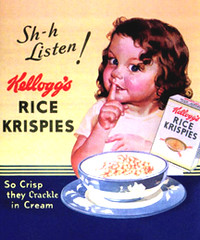Last year, most people said it wouldn’t happen. Now it is happening out of desperation. The people who social media participants and bloggers call “old media” are working as quickly as possible to change everything and become the, um, new new media.
Old media is not struggling; they are fighting for survival.
According to Bloomberg, BusinessWeek is doing everything possible to keep up. The magazine is undergoing a facelift and adding stories on new products and personal finance. It is updating its logo and typefaces.
Advertising pages dropped 20 percent and advertising sales dropped 15 percent. Hard copy circulation is down 1.2 percent. Online, the story is different. Its Internet readership is up to 6.5 million unique visitors a month from 1.7 million a month in 2004. But ad sales online only account for 18 percent of its revenue.
“All traditional business publishers are struggling to find the right formula,” said Peter Kriesky, Kreisky Media Consultancy in New York. “None of them have reached the promised land.''
What if there is no formula?
ABC seems to be asking the same. So while it tends to be the quietest of all networks about its plans for network-Internet convergence, The New York Times says it is the only major network that is using the staff of its evening newscast to produce a separate and distinct daily program for a Web audience as opposed to repackaging (that’s largely true).
The 15-minute Webcasts often feature Charles Gibson in the anchor chair and ABC News correspondent. Bill Blakemore recently finished a special on global warming. I watched their Web segment on the Pennsylvania shooting plot this morning. It’s not perfect (ABC needs a full screen option, among other things), but it is a step in the right direction and more promising than repackage plus option being made by other networks.
Innovation will lead the way.
This is not to say traditional media is not content relevant (they are). They simply lack in platform building, appropriate technology, and understanding active consumers (as opposed to passive readers and viewers). Too many are following old models and formulas.
Time Magazine’s Bill Tancer found one piece of the puzzle: according to the Solutions Research Group, roughly 37 percent of the U.S. population over the age of 12 use their computers while watching television at home.
What's the answer? It seems to me that consumers want integrated print, broadcast, and Internet. And while mobile devices seem to be chugging along, we’re still past prime time for a dual-device entertainment interface that allows people to watch programming on a big screen while participating online with their smaller screened laptops that function like a universal remote. Of course, all this assumes cable companies stop double dipping by charging people twice for essentially the same service.
Sounds like an Apple of an opportunity to me.
As for where print and broadcast seem to be missing the mark online right now, maybe that’s better served up in the weeks ahead. At the moment, I have some old media ads to write. As much as times are changing, some things have not changed.

Old media is not struggling; they are fighting for survival.
According to Bloomberg, BusinessWeek is doing everything possible to keep up. The magazine is undergoing a facelift and adding stories on new products and personal finance. It is updating its logo and typefaces.
Advertising pages dropped 20 percent and advertising sales dropped 15 percent. Hard copy circulation is down 1.2 percent. Online, the story is different. Its Internet readership is up to 6.5 million unique visitors a month from 1.7 million a month in 2004. But ad sales online only account for 18 percent of its revenue.
“All traditional business publishers are struggling to find the right formula,” said Peter Kriesky, Kreisky Media Consultancy in New York. “None of them have reached the promised land.''
What if there is no formula?
ABC seems to be asking the same. So while it tends to be the quietest of all networks about its plans for network-Internet convergence, The New York Times says it is the only major network that is using the staff of its evening newscast to produce a separate and distinct daily program for a Web audience as opposed to repackaging (that’s largely true).
The 15-minute Webcasts often feature Charles Gibson in the anchor chair and ABC News correspondent. Bill Blakemore recently finished a special on global warming. I watched their Web segment on the Pennsylvania shooting plot this morning. It’s not perfect (ABC needs a full screen option, among other things), but it is a step in the right direction and more promising than repackage plus option being made by other networks.
Innovation will lead the way.
This is not to say traditional media is not content relevant (they are). They simply lack in platform building, appropriate technology, and understanding active consumers (as opposed to passive readers and viewers). Too many are following old models and formulas.
Time Magazine’s Bill Tancer found one piece of the puzzle: according to the Solutions Research Group, roughly 37 percent of the U.S. population over the age of 12 use their computers while watching television at home.
What's the answer? It seems to me that consumers want integrated print, broadcast, and Internet. And while mobile devices seem to be chugging along, we’re still past prime time for a dual-device entertainment interface that allows people to watch programming on a big screen while participating online with their smaller screened laptops that function like a universal remote. Of course, all this assumes cable companies stop double dipping by charging people twice for essentially the same service.
Sounds like an Apple of an opportunity to me.
As for where print and broadcast seem to be missing the mark online right now, maybe that’s better served up in the weeks ahead. At the moment, I have some old media ads to write. As much as times are changing, some things have not changed.






















